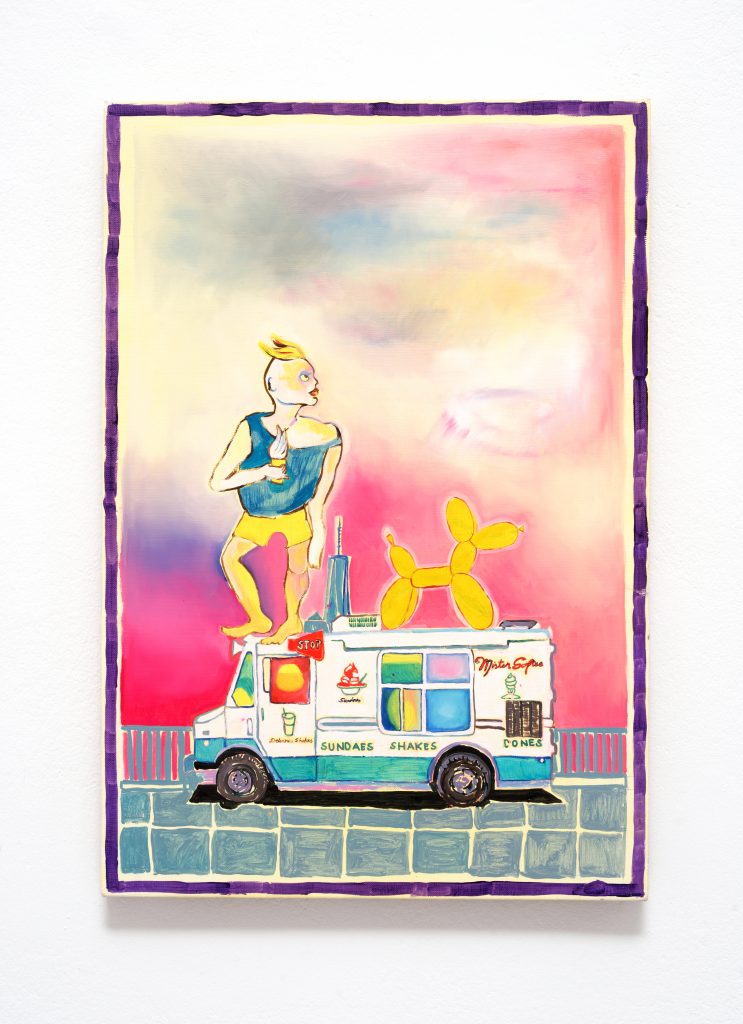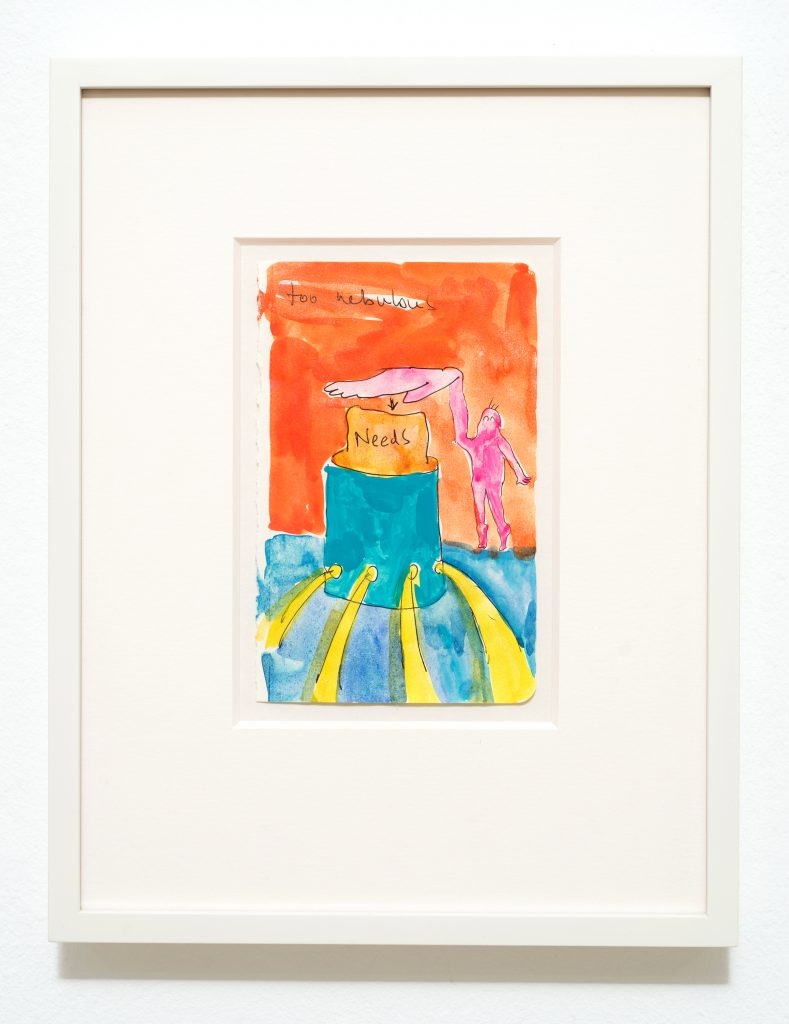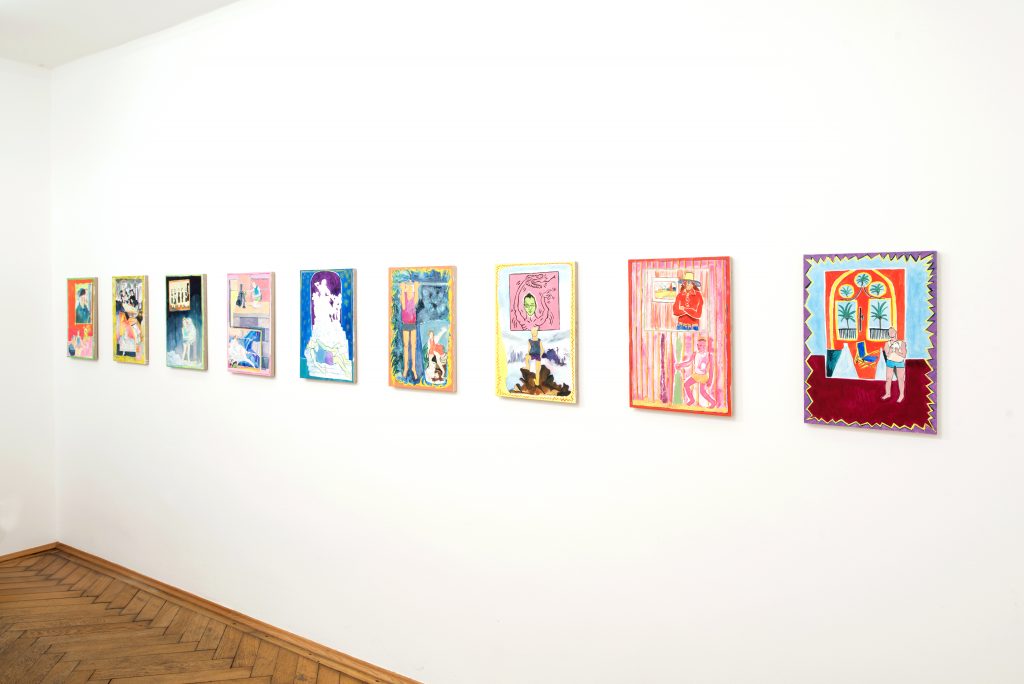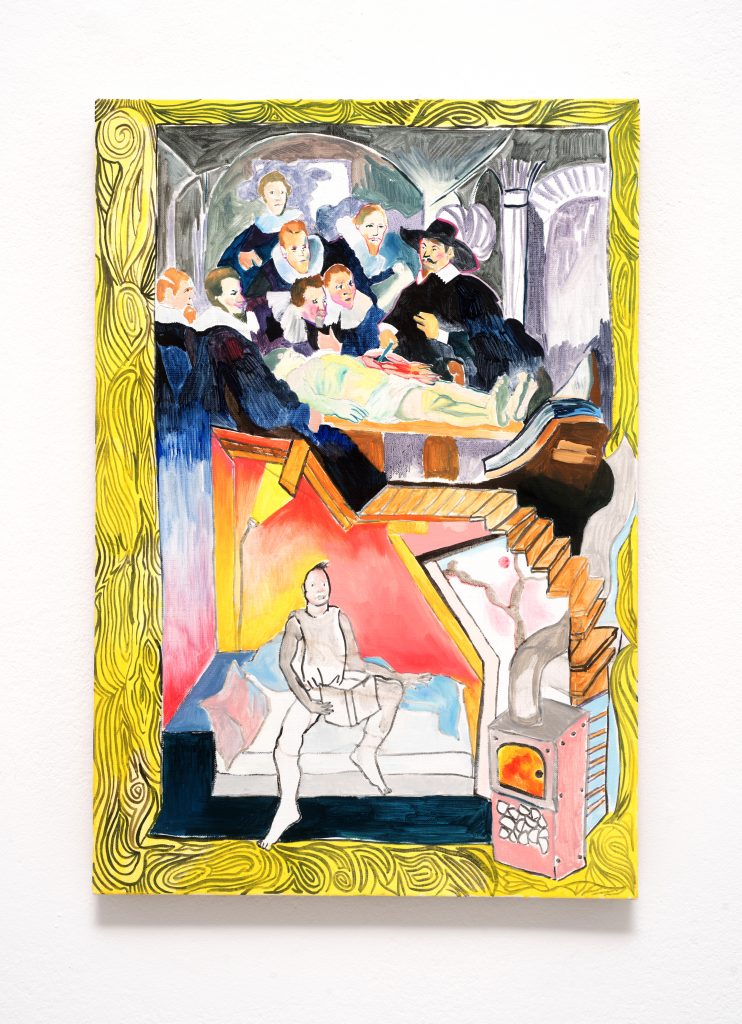
Installation view

Installation view

Drink before you‘re thirsty (Pure), 2021
Cardboard, metal spring, acrylic glass, LED, aluminium can, hologram sticker, chain
Dimensions variable

Drink before you‘re thirsty (Tangerine), 2021
Cardboard, metal spring, acrylic glass, LED, aluminium can, hologram sticker, chain
Dimensions variable

Counting Hazards, 2021
Oil and ink on canvas
48,26 x 33,02 cm

Schon besser im Centern, 2020
Oil on canvas
48,26 x 33,02 cm

Butterkremige Zuckerkrusten, 2021
Oil on canvas
48,26 x 33,02 cm

Das Sublime verstehen, 2021
Oil on canvas
48,26 x 33,02 cm

Liberty Painting, 2020
Oil on canvas
48,26 x 33,02 cm

Installation view

Scrap Time, 2021
Oil and pen on canvas
48,26 x 33,02 cm

Another Hard Day in the Office, 2021
Oil on canvas
48,26 x 33,02 cm

Dreaming Big, 2021
Oil and marker on canvas
48,26 x 33,02 cm

Es war schon ein Schock als er zugebissen hat, 2021
Oil and ink on canvas
48,26 x 33,02 cm

Balzac, 2021
Oil on canvas
48,26 x 33,02 cm

Stay Cool and Take It Ezzz, 2021
Oil, acrylic and ink on canvas
48,26 x 33,02 cm

Just Kidding Nobody Sleeps Better, 2021
Oil, acrylic and ink on canvas
48,26 x 33,02 cm

Installation view

Installation view

Colorful Wheel #1, Version 2, 2021
Please spin the wheel to the right as fast as you can!
Metal wheel mounted on wood stool, LED lights, battery
139 cm Ø 64 cm

Ponyboy Schmidt, 2021
Pen, pencil, ink and watercolour on paper
14 x 9 cm

Das beste Leben im Traum, 2018
Pen, pencil, ink and watercolour on paper
14 x 9 cm

Hamster Kontrapost, 2019
Pen, pencil, ink and watercolour on paper
14 x 9 cm

Needs Extruder, 2021
Pen, pencil, ink and watercolour on paper
14 x 9 cm

Convincing the Guy at the Loading Dock That Everything Is Alright, 2021
Pen, pencil, ink and watercolour on paper
14 x 9 cm

3D-Letters, My Steckenpferd, 2020
Pen, pencil, ink and watercolour on paper
14 x 9 cm

No Regrets at Tompkins Square Park, 2021
Pen, pencil, ink and watercolour on paper
14 x 9 cm

Red Star, 2019
Video with sound, 1242 x 2208 px
1:00 min
Edition 2+2 AE

Time Square, 2020
Cardboard, Sugar, LED, Microcontroller
61 x 113 x 5 cm

Installation view

Spinning Vinyls, 2020
Oil on canvas
48,26 x 33,02 cm

Pipe Down, 2020
Oil on canvas
48,26 x 33,02 cm

Yellow Snow, 2020
Oil on canvas
48,26 x 33,02 cm

Dünne Luft, 2020
Oil on canvas
48,26 x 33,02 cm

At the Edge of America, 2019
Oil on canvas
48,26 x 33,02 cm

K as in Kampftag, 2020
Oil on canvas
48,26 x 33,02 cm
Wie eine Riesin steht die Künstlerin auf dem Dach eines Eiswagens. In der Rechten hält sie eine Waffel mit gespritzter Füllung, die spontan an die Fackel der Statue of Liberty denken lässt. Rechts von ihr steht eine Skulptur von Jeff Koons, und scheinbar auch auf dem Dach des Eiswagens erscheint dazwischen in einer horizontlosen Ferne die Silhouette des One World Trade Center. Das Mobil steht auf einem schmalen, mit Platten belegten Streifen vor einer Brüstung, wie auf einer Brücke. Und wie in der Mittagshitze ist es unter dem Auto schwarz. Alles andere dagegen könnte aus den Primärfarben Rot, Gelb und Blau bestehen oder damit gefärbt sein. Im Himmel erscheinen die Farben verdünnt, überlagert, verwischt, gleichsam wie Träume zu Schäumen werden. Wenn man sich die Bühne leer denkt, bedeckt der Himmel vier Fünftel der Leinwand. Ein neu erworbenes Smartphone meldet sich genauso wie jene von Möglichkeit schwangere Tiefe, die Heines Rede von einer „romantischen Schule“ noch immer zu einem Versuch macht.
Bereits um 1800 hat Runge mehrfach von dem „Totaleindruck“ gesprochen, den Kunstwerke auf Betrachtende machen. Die Arbeiten von Kristina Schmidt prägen sich vor allem als farbige ein. Es gibt „viel“ zu sehen, man denkt auch an „alles“. „Meine Aufmerksamkeitsspanne ist ziemlich kurz.“ Das gilt aber für die ganze Zeit. Dennoch ist es zu viel und gleichzeitig zu einfach, ihre Farben nur poppig zu nennen. Kristina Schmidts neue Skulpturen dienen im wörtlichen und übertragenen Sinn als Bildschirme. Aber sobald die Bilder auf so einem Träger in den realen Raum eintreten, entziehen sie sich. In Drink before you´re thirstyfinden wir LED-Lichter, eine schimmernde leere Getränkedose, einen Infinity Mirror, also eher eine Fata Morgana als eine Oase. Die Arbeit Red Star leuchtet auf einem Smartphone. Und die Hawwai-Blume in Colorful Wheel #1 (Version 2) erscheint nur, wenn das Rad in Bewegung ist. Schmidts Farben sind also nicht nur geerdet, weil man die Farben suchen muss, die nicht zugleich Zeichen sind. Darüber hinaus, wie die Färbung des Himmels, ist die bloße Erscheinung selbst nicht zu greifen, materiell nicht, aber auch nicht als Bedeutung.
Gewiss gibt es keine Erzählung in diesem Werk, die nicht auch gesellschaftlich ist. Aber diejenige, die das, was von außen kommt, aufnimmt und mitteilt, ist immer die Künstlerin selbst. Die Brechung durch die Erfahrung geschieht je und je, vereinzelt wie das Subjekt, das distanziert sein kann wie Friedrichs Wanderer über dem Nebelmeer oder versunken wie Füsslis Träumende. Warum bringt Kristina Schmidt dann zusätzlich zu Stay Cool scheinbar ein Kollektiv ins Spiel? Gleichzeitig mit ihrer Einzelausstellung in der Galerie Christine Mayer findet auf dem Gehsteig an der Liebigstraße eine Art Gruppenausstellung von P. A. D. (Project Art Distribution) aus New York statt, die die Statue of Liberty in neuen Formulierungen zeigt und klein genug, um zunächst über den Atlantik bewegt zu werden. In einer Mail an Christine Mayer sieht Kristina Schmidt in diesem gemeinsamen Nenner den Hinweis auf eine zusammenhaltende Textur oder Struktur und erwägt „wie Monumente, Denkmäler und Kunst/Kultur für Künstler*innen als Wegmarken funktionieren. Unterschiedliche gesellschaftliche Fragestellungen überlagern oder dominieren dann ästhetische Entscheidungen.“
Stay Cool kann bedeuten, den Widerspruch zwischen Individuum und Kollektiv auszuhalten. In Das Kapital von Marx würde es aber „trivial“ heißen, darin nicht mehr als die Einsicht zu finden, dass auch Künstler*innen vergleichbar sind und auch Kunstwerke Waren. Denn Marx hat den Fetischcharakter der Ware nicht nur enthüllt, sondern von seinem Geheimnis gesprochen. Um „eine Analogie zu finden“ zu dem, was die Dinge in der Gesellschaft bedeuten, „müssen wir in die Nebelregion der religiösen Welt flüchten. Hier scheinen die Produkte des menschlichen Kopfes mit eignem Leben begabte, untereinander und mit den Menschen in Verhältnis stehende selbständige Gestalten.“ Von Marx stammt auch die Rede von diesen Produkten als Überbauten auf einem ökonomischen Unterbau. Man hat bemerkt, dass diese Beziehung auch umgedreht worden ist, der Kapitalismus auf dem Boden des Protestantismus erwachsen. Aber auch Max Weber kann nicht erklären, warum, er kann nur erzählen, dass das so ist. Und die Erzählungen bleiben trivial, klein, sie werden nicht groß, solange sich unten und oben, oben und unten mechanisch, als Ursache und Wirkung, aktiv und passiv, nicht analog zueinander verhalten. Wenn die Produkte des menschlichen Kopfes mit eigenem Leben begabt heißen, dann zeichnet Marx in Wahrheit nicht eine, sondern zwei Welten. Das Geheimnis, das logisch ein Widerspruch ist, entsteht immer dann, wenn sich eine neue Welt in der Welt einstellt. So ist das Amerika, das Kristina Schmidt zeigt, bekannt und gleichzeitig unbekannt. Das Bild 20 LOL 20 zeigt in ihren Worten eine Szene, „ bei der Lulu und Whiskey (das Pony und der Esel von Arnold Schwarzenegger) das Pferdewette-Ticket in der Wettbar aus der Hosentasche klauen. Die (Kapitolinische B. R.) Wölfin kam, glaube ich, dazu, um das allgemeine Bildniveau anzuheben.“ Die Wölfin hat einst die Gründer Roms als Mutter genährt. Im Hinblick auf Amerika und die Antike, das Feld, auf dem die Statue of Liberty möglich war, heißt es 1944: „Es war, wie wenn der römische Adler sich in Amerika niedergelassen hätte und in einer neuen Form, als amerikanischer Adler die Fahne ergriff, das Zeichen der Vereinigten Staaten.“ (T. F. Hamlin, Greek revival architecture in America)
Die Erzählungen, die die Bilder von Kristina Schmidt enthalten, aber auch anstoßen, folgen weder dem Interesse, Ideologien zu dekonstruieren, noch dem Bedürfnis, Banales zu überhöhen. Jene Entzauberung und diese Verzauberung bilden zusammen eine kollektive Erfahrung. Von dieser können „wir“ aber erst nur berichten, dass jenes Rationale dieses Irrationale ausschließt und umgekehrt. Undenkbar scheint eine Erzählung, die groß ist, weil sie beides verbindet. Und das gemalte Bild scheint deren Unmöglichkeit zu verkörpern als ein Raum, der fast nichts ist neben einem Fünfjahresplan. Kristina Schmidt wendet diese Unmöglichkeit zu einer Möglichkeit, indem ihre eigene Welt in der Form des Bildes allgemein lesbar wird. 2020 war diese Welt in der Galerie Christine Mayer zu sehen als Schmidti City, eine mit dem eigenen Namen bezeichnete, besondere Welt. 2021 tritt zu Schmidts zweiter Einzelausstellung in der Galerie die Präsentation von P. A. D. als pars pro toto für eine allgemeine Welt. Damit zeigt Stay Cool ihre besondere Welt als Welt in der Welt. Erst recht auf diesem doppelten Boden erwächst die politische Bedeutung, die Kristina Schmidt Bildern zuspricht, auf dem eigenen Boden der Malerei.
Berthold Reiß
Like a giantess, the artist stands on the roof of an ice cream truck. In her right hand she holds a waffle with filling, which spontaneously evokes the torch carried by the Statue of Liberty. To her right there is a sculpture by Jeff Koons, and in between, seemingly also on the roof of the ice cream truck, the silhouette of the One World Trade Center appears in the distance. The vehicle is placed on a narrow strip of flagstones in front of a parapet, as if on a bridge. Underneath the car it is completely black, as if the midday sun was beating down. Everything else, however, could be made of or coloured with the primary colours of red, yellow and blue. In the sky, the colours appear diluted, superimposed, blurred, just like when dreams transform into effervescence. If you think of the stage as empty, the sky covers four-fifths of the canvas. A recently purchased smartphone announces itself, as does the depth, pregnant with possibilities, that Heine had attempted to reign in with his notion of a “romantic school”.
As early as around 1800, Runge had repeatedly spoken of the “overall vision” (Totaleindruck) that works of art produce in the viewer. Kristina Schmidt’s works leave a lasting impression, above all as colourful ones. There is “a lot” to see, perhaps even “everything.” “My attention span is pretty short.” But that is true for the entire time. Still, it is too much and at the same time too easy to call her colours just pop. Kristina Schmidt’s new sculptures serve as screens, literally and figuratively. But as soon as the images enter real space on such a carrier, they elude us. In Drink before you’re thirsty, we encounter LED lights, a shimmering empty soda can, and an Infinity Mirror; in other words, a mirage rather than an oasis. The work Red Star glows on a smartphone. And the Hawaiian flower in Colorful Wheel #1 (version 2) appears only when the wheel is in motion. Schmidt’s colours, then, are grounded not only because one must search for those colours that are not also signs. Beyond that, just like the colours of the sky, the work’s very appearance itself cannot be grasped – neither materially, nor as meaning.
Certainly there is no narrative in this work that is not also social. But the one who absorbs and communicates what comes from outside is always the artist herself. The refraction through experience happens now and then, sporadically, just like the subject who appears distanced like Friedrich’s wanderer above the sea of fog or absorbed like Füssli’s dreamers. Why then does Kristina Schmidt additionally to Stay Cool seem to bring a collective into play?
Simultaneously with her solo show at Galerie Christine Mayer, a kind of group show by P. A. D. (Project Art Distribution) from New York is taking place on the Liebigstrasse sidewalk, showing the Statue of Liberty in new formulations and as small enough to be moved across the Atlantic for the time being. In an email to Christine Mayer, Kristina Schmidt sees in this common denominator the hint of a cohesive texture or structure and considers “how monuments, memorials, and art/culture function as waymarks for artists. Different social issues then overlay or dominate aesthetic choices.”
‘Stay Cool’ can mean enduring the contradiction between the individual and the collective. In Marx’s Capital, however, it would be “trivial” to find in it nothing more than the insight that even artists are comparable and works of art commodities. For Marx not only revealed the fetish character of the commodity but spoke of its secret nature. To “find an analogy” to what objects mean in society, “we must have recourse to the mist-enveloped regions of the religious world. In that world, the productions of the human brain appear as independent beings endowed with life, and entering into relation both with one another and the human race.”In addition, Marx spoke of these products as superstructures on an economic substructure. We have seen this relationship also reversed, capitalism growing on the soil of Protestantism. But even Max Weber cannot explain why, he can only tell us that it is so. And the stories remain trivial, small, they do not loom large – as long as below and above, above and below, relate to each other mechanically, as cause and effect, active and passive, rather than in an analogous way. If the products of the human head are endowed with a life of their own, then Marx is in fact drawing not on one but two worlds. The mystery, itself a contradiction, always arises when a brand-new world appears in this, in our world. The America that Kristina Schmidt shows, then, is known and unknown at the same time. The work 20 LOL 20 shows, in her words, a scene “where Lulu and Whiskey (Arnold Schwarzenegger’s pony and donkey) steal the horse race betting ticket out of someone’s pocket at the bookies bar. The (Capitoline B. R.) she-wolf came in, I think, to elevate the overall niveau of the work.” The she-wolf once nurtured the founders of Rome as a mother. With regard to America and antiquity, the field that made possible the Statue of Liberty, it was said in 1944 that “[i]t was as if the Roman eagle had taken up residence in America, and, in a new form, seized the flag as an American eagle, the symbol of the United States.” (T. F. Hamlin, Greek Revival Architecture in America)
The narratives contained in as well as inspired by Kristina Schmidt’s paintings follow neither an interest in deconstructing ideologies nor the need to exaggerate the banal. Together, disenchantment and enchantment form a collective experience. Of this, however, “we” can only report that the rational excludes the irrational and vice versa. Unthinkable a grand narrative that combines both. The painted image seems to embody this impossibility as a space that amounts to almost nothing, compared to a five-year plan. Kristina Schmidt turns this impossibility into a possibility by making her own world universally legible in the form of the painting. In 2020, this world was on view at Galerie Christine Mayer as Schmidti City, a distinct world labelled with her own name. In 2021, Schmidt’s second solo exhibition at the gallery is accompanied by the presentation of P. A. D., a pars pro toto for a more universal world. Stay Cool thus shows her specific world as a world within the world. And it is on this double bottom that the political meaning asserted in Kristina Schmidt’s paintings grows, on the very grounds of painting itself.
Berthold Reiß
Translated by Jennifer Leetsch